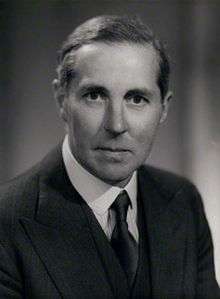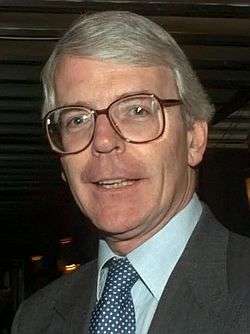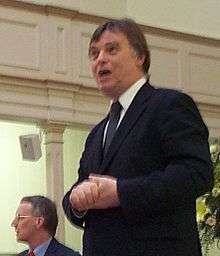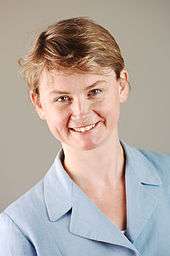Chief Secretary to the Treasury
| Chief Secretary to the Treasury | |
|---|---|
|
Arms of Her Majesty's Government | |
| HM Treasury | |
| Style | The Right Honourable |
| Appointer |
The British Monarch on advice of the Prime Minister |
| Term length | No fixed term |
| Inaugural holder | Henry Brooke |
| Formation | 8 October 1961 |
| Website | HM Treasury |
.svg.png) |
| This article is part of a series on the politics and government of the United Kingdom |
|
|
|
|
The Chief Secretary to the Treasury is the second most senior ministerial position in HM Treasury, after the Chancellor of the Exchequer. It was created in 1961, to share the burden of representing the Treasury with the Chancellor of the Exchequer.
Between 1961 and 2015 the holder of the post of Chief Secretary to the Treasury was automatically a member of the Cabinet making the Treasury the only Department to have two ministers automatically serving in the Cabinet.[1][2] Since 2015, however, the status of the Chief Secretary to the Treasury has been reduced to an "also attending Cabinet" role.
The position's responsibilities include negotiating with departments about budget allocations, public sector pay, and procurement policy.
Chief Secretaries to the Treasury
Colour key (for political parties):
Conservative
Labour
Liberal Democrats
| Name | Portrait | Term of office | Political party | Prime Minister | Chancellor | |||
|---|---|---|---|---|---|---|---|---|
| Henry Brooke |  | 9 October 1961 | 13 July 1962 | Conservative | Macmillan | Lloyd | ||
| John Boyd-Carpenter |  | 13 July 1962 | 16 October 1964 | Conservative | Maudling | |||
| Home | ||||||||
| John Diamond |  | 20 October 1964 | 19 June 1970 | Labour | Wilson | Callaghan | ||
| Jenkins | ||||||||
| Maurice Macmillan |  | 23 June 1970 | 7 April 1972 | Conservative | Heath | Macleod | ||
| Barber | ||||||||
| Patrick Jenkin |  | 7 April 1972 | 8 January 1974 | Conservative | ||||
| Thomas Boardman |  | 8 January 1974 | 4 March 1974 | Conservative | ||||
| Joel Barnett |  | 7 March 1974 | 4 May 1979 | Labour | Wilson | Healey | ||
| Callaghan | ||||||||
| John Biffen |  | 5 May 1979 | 5 January 1981 | Conservative | Thatcher | Howe | ||
| Leon Brittan | | 5 January 1981 | 11 June 1983 | Conservative | ||||
| Peter Rees |  | 11 June 1983 | 2 September 1985 | Conservative | Lawson | |||
| John MacGregor |  | 2 September 1985 | 13 June 1987 | Conservative | ||||
| John Major |  | 13 June 1987 | 24 July 1989 | Conservative | ||||
| Norman Lamont |  | 24 July 1989 | 28 November 1990 | Conservative | Major | |||
| David Mellor |  | 28 November 1990 | 10 April 1992 | Conservative | Major | Lamont | ||
| Michael Portillo |  | 10 April 1992 | 20 July 1994 | Conservative | ||||
| Clarke | ||||||||
| Jonathan Aitken |  | 20 July 1994 | 5 July 1995 | Conservative | ||||
| William Waldegrave |  | 5 July 1995 | 2 May 1997 | Conservative | ||||
| Alistair Darling |  | 3 May 1997 | 27 July 1998 | Labour | Blair | Brown | ||
| Stephen Byers |  | 27 July 1998 | 23 December 1998 | Labour | ||||
| Alan Milburn | | 23 December 1998 | 11 October 1999 | Labour | ||||
| Andrew Smith |  | 11 October 1999 | 29 May 2002 | Labour | ||||
| Paul Boateng | | 29 May 2002 | 6 May 2005 | Labour | ||||
| Des Browne |  | 6 May 2005 | 5 May 2006 | Labour | ||||
| Stephen Timms |  | 5 May 2006 | 27 June 2007 | Labour | ||||
| Andy Burnham |  | 28 June 2007 | 24 January 2008 | Labour | Brown | Darling | ||
| Yvette Cooper |  | 24 January 2008 | 5 June 2009 | Labour | ||||
| Liam Byrne | | 5 June 2009 | 11 May 2010 | Labour | ||||
| David Laws |  | 12 May 2010 | 29 May 2010 | Liberal Democrat | Cameron (Coalition) |
Osborne | ||
| Danny Alexander |  | 29 May 2010 | 7 May 2015 | Liberal Democrat | ||||
| Greg Hands | | 11 May 2015 | 14 July 2016 | Conservative | Cameron (II) | |||
| David Gauke |  | 14 July 2016 | Incumbent | Conservative | May | Hammond | ||
See also
- Secretary to the Treasury
- Financial Secretary to the Treasury
- Economic Secretary to the Treasury
- Exchequer Secretary to the Treasury
- Paymaster General
